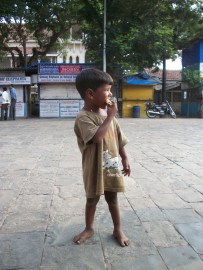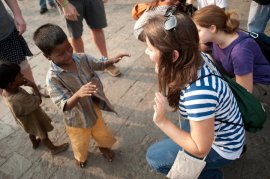On December 31 every year, I love looking back over the last year and reflecting on what God had done and major events that occurred. But this year was different. As midnight approached, I stood and watched a crowd of 2,000 college students at Cru’s annual Christmas Conference in Indianapolis worship in the New Year (pictured below). I realized at this point that I hadn’t done my normal reflection. And, to be honest, I didn’t want to.
I didn’t want to think about all the changes that happened, the pain of major transitions and trials, walking through circumstances and situations that I never asked to walk through, the lack of joy I experienced throughout the year, or even just that a lot of what happened didn’t go the way I expected or wanted it to go. Throughout the past year, and probably longer than that, I’ve found myself on a roller coaster, most of the time being on the losing side of the fight for joy.
In a nutshell, in the last year, I finished a thesis, graduated (pictured below), went to Europe, visited countless doctors in order to seek healing for years of exhaustion and a barely functioning body, raised support to spend a year in fulltime ministry, watched most of my closest friends move from Athens and start new lives elsewhere, celebrated the marriages of three of my best friends, started an internship with Cru, and walked through a lot of confusion, disappointment, failure, and hurt from the past and the present.

(For the sake of this blog, I forced myself to look back on the past year. I’m thankful God pushed me out of my stubbornness to do it, because I know it’s good for me. And through looking back, I’ve also been able to see how He’s worked.)
But I’m so thankful that the Lord, in His kindness and grace, didn’t leave me in that state. A turning point really came in October when my friend/roommate/coworker/boss/etc. asked me how my fight for joy was going. And then opened the floodgates of my tear ducts. The truth was I wasn’t fighting for joy. I was stuck in a wilderness of hopelessness, thinking that things would never change. That I would never change. I couldn’t see what God could possibly be doing with my heart or how any of what He was doing could be good for me.
As the tears streamed, my friend reminded me of simple truths. Truths that I knew but wasn’t believing. Along with Scripture, these words still ring in my head:
“The Lord shows His kindness and grace by refining your heart.”
“In His kindness, He doesn’t leave you as you are. The Lord cares too much to leave you unchanged.”
“We don’t get to choose how we glorify God, but we can choose whether we walk through it faithfully.”
“We need to praise and thank God in all circumstances.”
“My life is not my own.”
“God works all things for the good of those who love Him.”
“Sanctification is a privilege, not a punishment.”
“God wants to take you from slavery to sin and your own heart to the freedom that He’s already given you in Christ.”
__
Seeing joy in Christ has been the theme of the last few months for me. I’ve noticed the theme in conferences I’ve attended, Scripture and articles I’ve read, songs I’ve listened to, and in the lives of the girls I disciple on campus. And God is putting these words constantly into practice.
Since October, the fight has become harder, but these truths and the promises of God are sinking deeper. It’s amazing how God uses circumstances and situations to show me my brokenness and need for a Savior. But God doesn’t stop there, He shows us that He has already overcome our brokenness and sin, and that we have freedom and victory only through His blood and the Gospel.
So, what’s my New Years resolution? To fight for the joy that God has already provided for me. To pray constantly that the Lord would open my eyes to see His kindness and grace in all circumstances, not just the ones that go the way I want them to go. To walk through my circumstances with thanksgiving and trust that God will not leave me unchanged. That I would see and experience the Gospel. That my heart and actions would glorify my Savior.
And I desire the same for you. In my next series of posts, I invite you to walk with me through my continuing fight for joy and the simple truths God has taught me in the last few months. I guarantee that the fight is not easy, but God wants us to experience the joy and the freedom that is in Him.
For today, I leave you with the words of Psalm 51:7-12.
“Cleanse me with hyssop,and I will be clean;
wash me, and I will be whiter than snow.
8 Let me hear joy and gladness;
let the bones you have crushed rejoice.
9 Hide your face from my sins
and blot out all my iniquity.
10 Create in me a pure heart, O God,
and renew a steadfast spirit within me.
11 Do not cast me from your presence
or take your Holy Spirit from me.
12 Restore to me the joy of your salvation
and grant me a willing spirit,to sustain me.”



